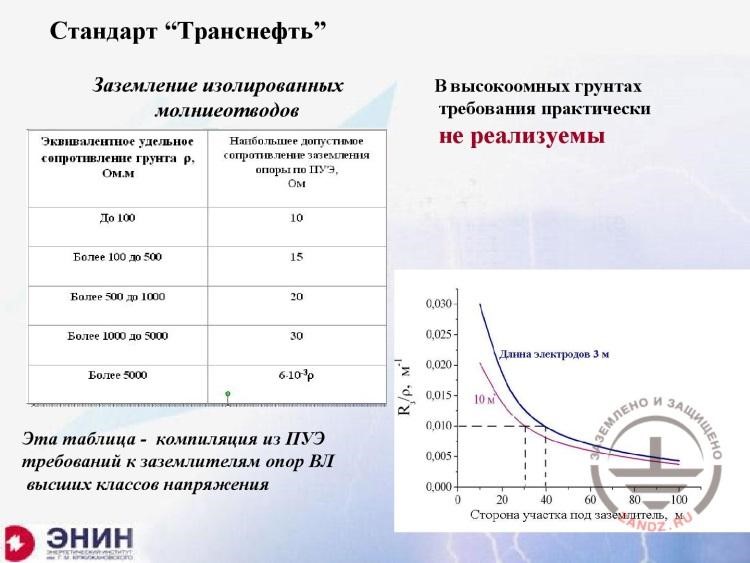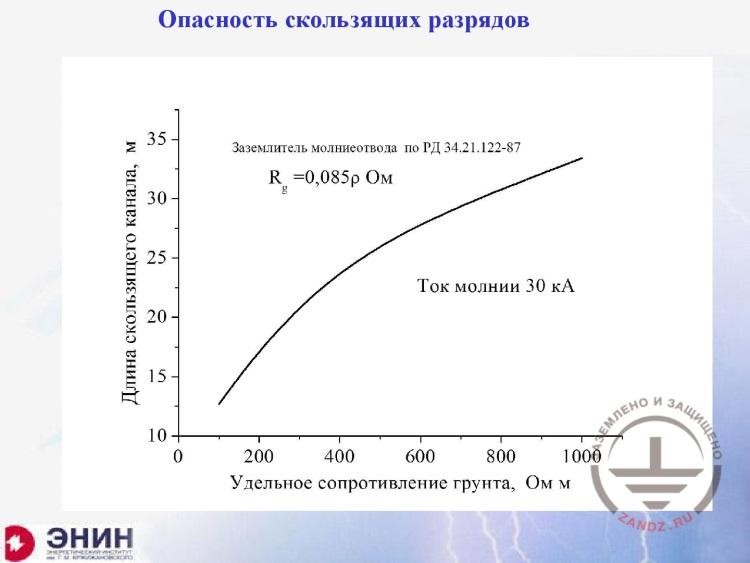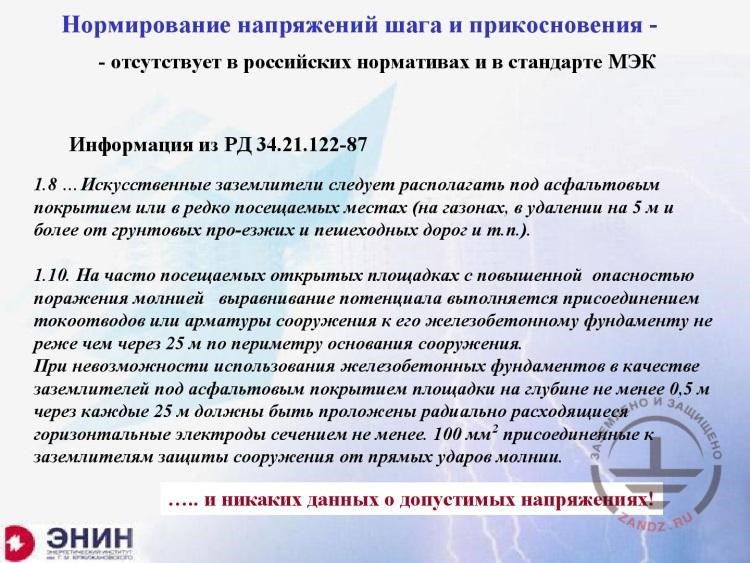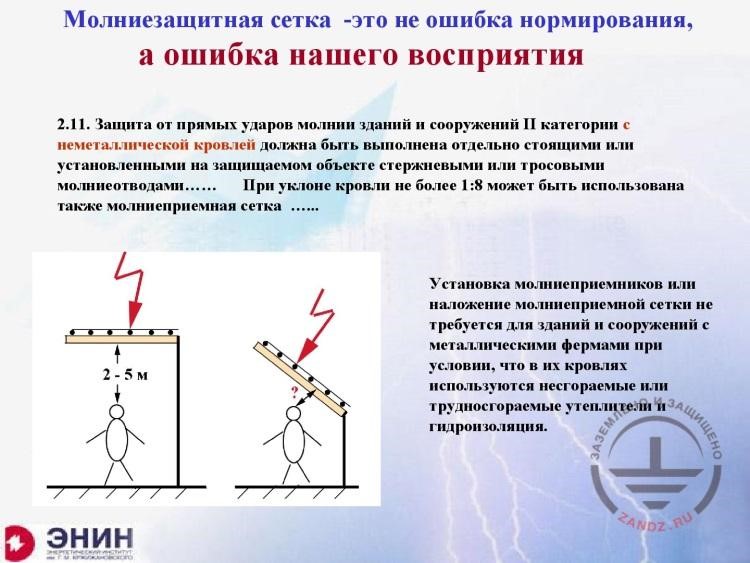The eighteenth webinar of "Earthing and Lightning Protection: Design Issues and Problems" series.
Webinar text. Page 3
Fast navigation by slides:
<< Page 1:
1. Conflicts in regulatory documents
2. Choosing external lightning arresters
3. Importance of height of a lightning arrester
4. Why is the IEC standard unacceptable?
5. IEC shielding angle method
6. Rolling sphere method
7. IEC methodology
8. RD and SO drawbacks
9. High lightning arrester: an obvious mistake!
10. Computer calculations
<< Page 2:
11. Protection zone reliability
12. Multiple lightning arresters
13. How to design without software?
14. Roof of a climate control device
15. Closed wire in SO-153
16. Parallels with the lightning rods
17. Problems when installing?
18. Bolt connection tests
19. How to be successful with Gostekhnadzor?
20. Earthing and lightning protection. IEC standard
Page 3:
21. Earthing in lightning protection. RD 34.21.122-87
22. The "Transneft" standard
23. Conductive coupling through the soil
24. Earthing circuit of an industrial facility
25. Creeping discharge hazard
26. Step and touch voltage rating
27. Step voltage at the 30 kA lightning current
28. Russian electrical safety standards
29. Lightning protection grid
30. Questions and answers
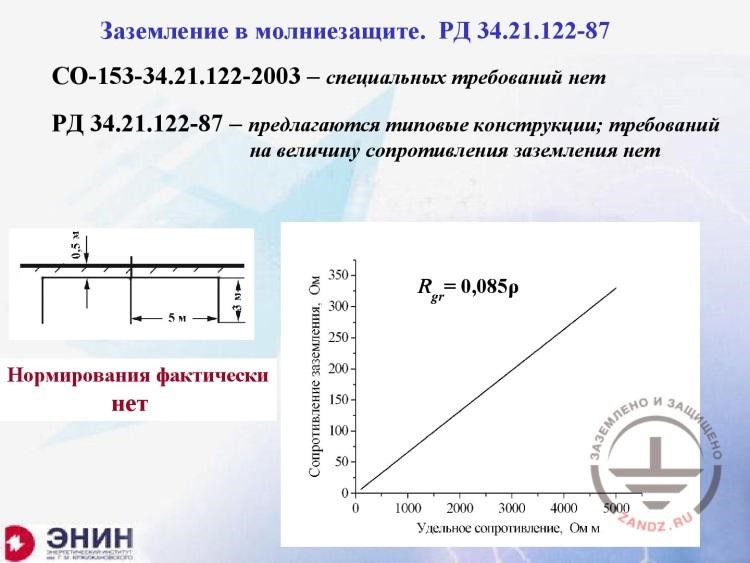
Earthing in lightning protection. RD 34.21.122-87
| Заземление в молниезащите. РД 34.21.122-87 | Earthing in lightning protection. RD 34.21.122-87 |
| СО-153.34.21.122-2003 – специальных требований нет | SO-153.34.21.122-2003 — no special requirements |
| РД 34.21.122-87 – предлагаются типовые конструкции; требований на величину сопротивления заземления нет | RD 34.21.122-87 — typical structures are offered; no requirements to earthing resistance |
| 0,5 м | 0.5 m |
| Нормирования фактически нет | Almost no rating |
| Сопротивление заземления, Ом | Сопротивление заземления, Ом |
| Удельное сопротивление, Ом м | Resistivity, Ohm m |
– The situation with the Russian documents is even worse. Document SO-153 does not contain any instructions on what value should the earthing resistance have. It has got no information about it. Document RD 34 does not contain any instructions on the earthing resistance but it contains the information on allowable dimensions of the earthing device. Here is the dimension of an earthing device, which is allowable according to RD 34; this is a horizontal bus about 10 m long and three rods of 5 or even 3 meters long. If one looks at the way this structure changes its earthing resistance in different soils, then we will see the following: in a very good soil, a black soil, the earthing resistance is about 10 Ohm, and it is considered to be acceptable, and in the soil of 3,000 Ohm*m, it is about 200 Ohm, and this is also considered to be acceptable. I do not understand how can the resistances that differ 20-fold can both be allowable? It cannot be true. What is this earthing resistance done for? First of all, to provide safety. So, in a black soil, people must be protected, and we must make sure that they do not die from the lightning strike, and in high-ohmic soils, in the rocks, it is not important. This cannot be considered a standard. This is not standardization. In general, this is something I cannot understand. Do you think that it is a single point?
| Стандарт «Транснефть» | “Transneft” standard |
| Заземление изолированных молниеотводов | Earthing of isolated lightning arresters |
| В высокоомных грунтах требования практически не реализуемы | In high-ohmic soils, the requirements are almost unable to implement |
| Эквивалентное удельное сопротивление грунта ρ, Ом м | Equivalent soil resistivity, Ohm m |
| Наибольшее допустимое сопротивление заземления опоры по ПУЭ, Ом | Maximum permissible earthing resistance for a support according to Electrical Installations Code, Ohm |
| До 100 | Up to 100 |
| Более 100 до 500 | 100 to 500 |
| Более 500 до 1000 | 500 to 1,000 |
| Более 1000 до 5000 | 1,000 to 5,000 |
| Более 5000 | Over 5,000 |
| Длина электродов 3 м | Electrode length is 3 m |
| Сторона участка под заземлитель, м | Side of an area for the earthing device, m |
| 10 м | 10 m |
| Эта таблица – компиляция из ПУЭ требований к заземлителям опор ВЛ высших классов напряжения | This table is a compilation from the EIC requirements to the high-voltage power line supports of the highest voltage classes |
– You can see the table with the earthing resistances that has been taken from the "Transneft" standard. And the "Transneft" standard has borrowed it from the Electrical Installations Code. The table is provided there for the earthing resistances for the high-voltage power line supports. The table shows that the soil with the resistivity of more than 1,000 Ohm*m requires the earthing resistance of 30 Ohm. I took some time to calculate what we have to do around the support located in an open field to provide its earthing resistance of 30 Ohm, e.g., in the soil with the resistivity of 3,000 Ohm*m. It turned out that we had to fill the area of 100 x 100 meters, and its depth of 10 meters is filled in with the metal. Only in this case we can obtain the earthing resistance required in the EIC. The question is: will somebody do that? Certainly, not. What will they do? They will do a hackwork. They will keep what they have done and will record in the documents what they had to do.
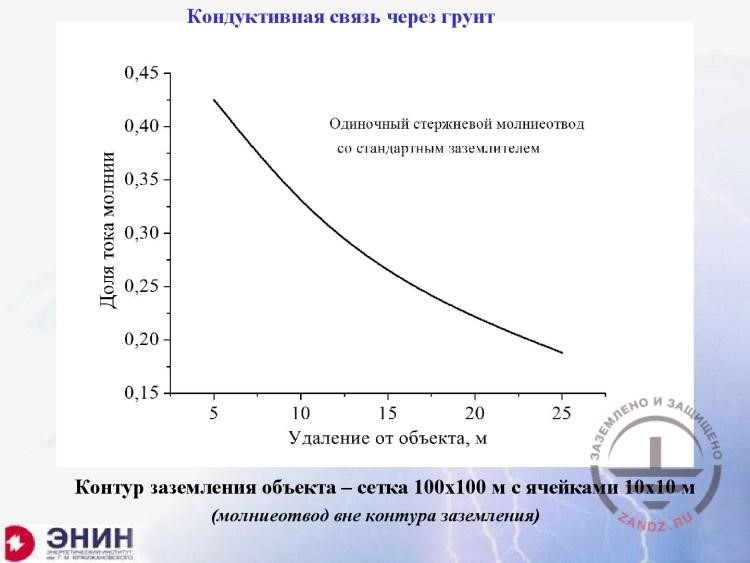
Conductive coupling through the soil
| Кондуктивная связь через грунт | Conductive coupling through the soil |
| Доля тока молнии | Portion of the lightning current |
| Удаление от объекта, м | Distance from the facility, m |
| Одиночный стержневой молниеотвод со стандартным заземлителем | Single lightning rod with the standard earthing device |
| Контур заземления объекта – сетка 100х100 м с ячейками 10х10 м (молниеотвод вне контура заземления) | Facility’s earthing circuit — grid 100 x 100 m with cells 10 x 10 m (lightning arrester outside the earthing circuit) |
– The designers are often said: "I have got a very expensive and very sensitive equipment that I cannot connect to the general earthing circuit in any way. Make an individual earthing circuit for me". Such an individual earthing circuit is not described in any document designed for the lightning protection, but the EIC contains such information. It states that all earthing devices should be combined into a single system (we would better stop here, but the EIC provides a comma), provided that, in this operating mode, such earthing should not be isolated. So, how can we make such an isolated earthing? You have got an earthing device, another earthing device, and an earth between them. But the earth is a conductor. And if you have got a current in one earthing device, a portion of this current will go into another earthing device through the earth. Look at what I have shown here. I had the following case: a single lightning rod with the standard earthing device made according to RD 34. And this is a distance from a facility having its own earthing circuit. And this curve demonstrates, which portion of the lightning current from the earthing device of a lightning arrester goes into the isolated earthing device of the facility. If the distance between them is 10 meters, then about 35% of the lightning current go there. It means that if the distance is long enough, then a significant portion of the lightning current goes the way it should not. This is only the tip of an iceberg.
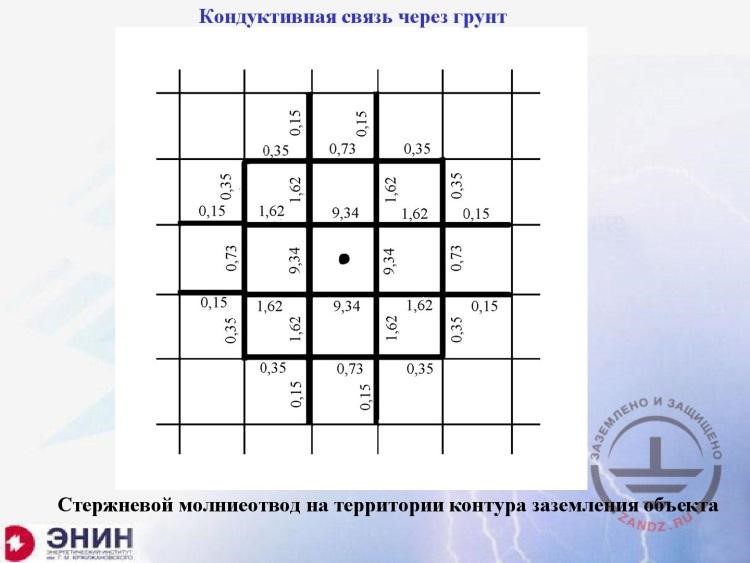
Earthing circuit for the industrial facility
| Кондуктивная связь через грунт | Conductive coupling through the soil |
| Стержневой молниеотвод на территории контура заземления объекта | Lightning rod on the territory of earthing circuit of a facility |
– This happens more often. It is a large earthing circuit for the industrial facility. It is provided as a grid having the step of 200 x 200 meters. Now, I have to install an individual earthing device within the area of this grid. Such individual earthing device; it stands out there, the earthing device of the lightning arrester. The distances are 5 meters; and it is shown on each side of the grid, which portion of the current in percent goes the way it should not. It turns out that the nearest grid elements are 9.5%, which is almost 40% of the current in total, while the remaining, further grids gain some more 20–25%. In total, it turns out that the isolated earthing device takes about 50–60% or even 65% of the lightning current. It is a very challenging task to make a separate individual earthing device. Usually, in such cases, this earthing device should be deepened for about 30 meters. And such deepening should be performed using an isolated cable that will be designed for the total earthing resistance, usually about one million volts. If you really need to create such expensive structure. But no regulatory document contains information on such an expensive structure.
| Опасность скользящих разрядов | Danger of creeping discharges |
| Длина скользящего канала, м | Creeping channel length, m |
| Удельное сопротивление грунта, Ом м | Soil resistivity, Ohm m |
| Ток молнии 30 кА | Lightning current 30 kA |
| Заземлитель молниеотвода по РД 34.21.122-87 | Earthing device of the lightning arrester according to RD 34.21.122-87 |
– At this point, I want to draw your attention to the following. In general, the current ingress I told about, through the soil conductivity, is not the most awful thing. When the lightning strikes the lightning arrester, a creeping spark channel that goes for several dozens meters and pulls almost all lightning current therewith, may spread from the earthing device of the lightning arrester, from its foundation. If you have got a soil with a resistivity of even 200 Ohm*m, which is a good soil, such channels may spread for about 15 meters, as you can see from the diagram. But if you have got a soil resistivity of 1,000 Ohm*m, which is also an acceptable value in Russia, the length of such channels may reach up to 35 meters. This is a fact. We have got nothing to oppose to this fact, but it is not taken into account during the design and remains beyond the designer's attention. There is one more thing that also remains beyond the designer's attention, which I am more concerned about.
| Нормирование напряжений шага и прикосновения – отсутствует в российских нормативах и в стандарте МЭГ | Rating of step and touch voltages is absent from the Russian standards and the IEC standard |
| Информация из РД 34.21.122-87 | Information from RD 34.21.122-87 |
| 1.8. …Искусственные заземлители следует располагать под асфальтовым покрытием или в редко посещаемых местах (на газонах, в удалении на 5 м и более от грунтовых проезжих и пешеходных дорог и т.п.) | 1.8. …The artificial earthing devices must be located under the asphalt coating or in non-public places (on the lawns, at the distance of 5 m and more from the earth roads and pedestrian roads, etc.). |
| 1.10. На часто посещаемых открытых площадках с повышенной опасностью поражения молнией выравнивание потенциала выполняется присоединением токоотводов или арматуры сооружения к его железобетонному фундаменту не реже чем через 25 м по периметру основания сооружения. | 1.10. In the open public areas with the increased risk of lightning strike, the potential equalization is performed by attaching the current collectors or the structure’s reinforcement to its reinforced concrete foundation not less than in 25 meters along the structure’s foundation perimeter. |
| При невозможности использования железобетонных фундаментов в качестве заземлителей под асфальтовым покрытием площадки на глубине не менее 0,5 м через каждые 25 м должны быть проложены радиально расходящиеся горизонтальные электроды сечением не менее 100 мм2 присоединенные к заземлителям защиты сооружения от прямых ударов молнии. | If it is impossible to use the reinforced concrete foundations as the earthing devices under the area’s asphalt coating at the depth of not less than 0.5 m, after each 25 m, radially diverging horizontal electrodes having a section of not less than 100 mm2 attached to the earthing devices of the structure protection against the direct lightning strike must be installed. |
| …и никаких данных о допустимых напряжениях! | … no data on allowable voltages! |
– You can often hear the following statements during watching the TV: the lightning struck the beach, and after that, 10 people were admitted to a hospital. The lightning struck the bus stop, and all the people were admitted to a hospital. The lightning struck the football field, and the entire football team was admitted to a hospital. What happened in these cases? The people were exposed to the step voltage. When the lightning current flows to the earth due to a very poor soil conductivity, and this conductivity is much worse than the metal conductivity. High voltages at small distances occur. One foot is located one meter from another, and you are affected by the voltage of several dozens kilovolts. And such voltage, if it does not kill people, makes them go to the hospital. The question is: do we have a rated step voltage stated somewhere, which acts when the lightning strikes a building, when the lightning strikes a lightning arrester, or when the lightning strikes, e.g., a monument? There is the monument for Gagarin located in the Leninsky Prospect, and the people are standing around it. Unfortunately, this question is left without an answer. What do the regulatory documents say about this? Talks. For example, RD 34 contains the following: if you have got public areas, then you need to equalize potentials using a metal grid or place an asphalt coating instead of such grid.
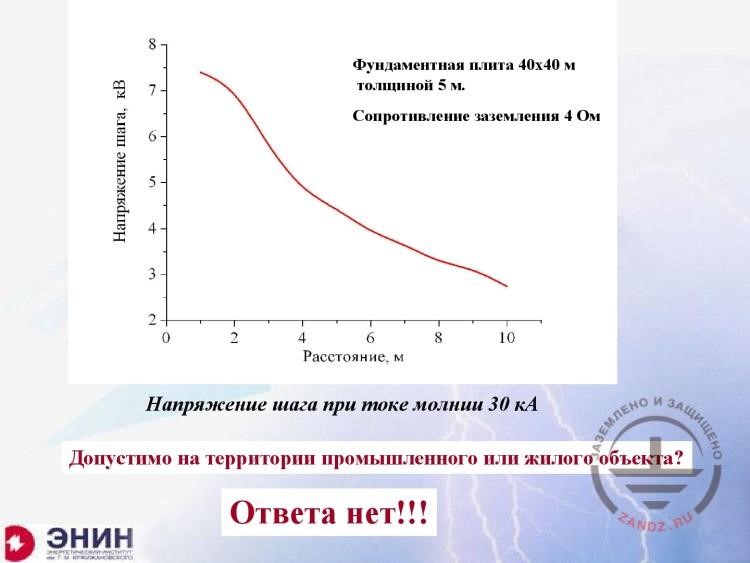
Step voltage with the 30 kA lightning current
| Напряжение шага, кВ | Step voltage, kV |
| Фундаментная плита 40х40 м толщиной 5 м. | Foundation plate 40 x 40 m and 5 m thick. |
| Сопротивление заземления 4 Ом | Earthing resistance 4 Ohm |
| Расстояние, м | Distance, m |
| Напряжение шага при токе молнии 30 кА | Step voltage at the lightning current 30 kA |
| Допустимо на территории промышленного или жилого объекта? | Allowable in the territory of an industrial or residential facility? |
| Ответа нет!!! | No answer!!! |
– The question is: how can the standards developed for this case be applied to the lightning? Do high voltages exist in nature near the residential buildings? Look at what I have done. I have taken a large building of 40 x 40 meters. It is an administrative building, a high-rise building that is installed not on the foundation but on the foundation plate that is 5 meters thick. And the earthing resistance obtained there was included into the data sheet contained in this document; 4 Ohm is an excellent earthing resistance. And now I show you the step voltage in kilovolts depending on the distance from the building wall. At the distance of 2 meters, it is about 7 kV, at the distance of 5 meters (a person goes along the sidewalk near the building), it is 4.5 kV. The question is: is it dangerous or not? How can we interpret this? Consider a high-rise building in Moscow, in the City Center. They are 300 meters high, and the lightning strikes them more than 10 times a year. The risk that people will be there is rather high. The question is: are there any standards for these cases? There are no standards.
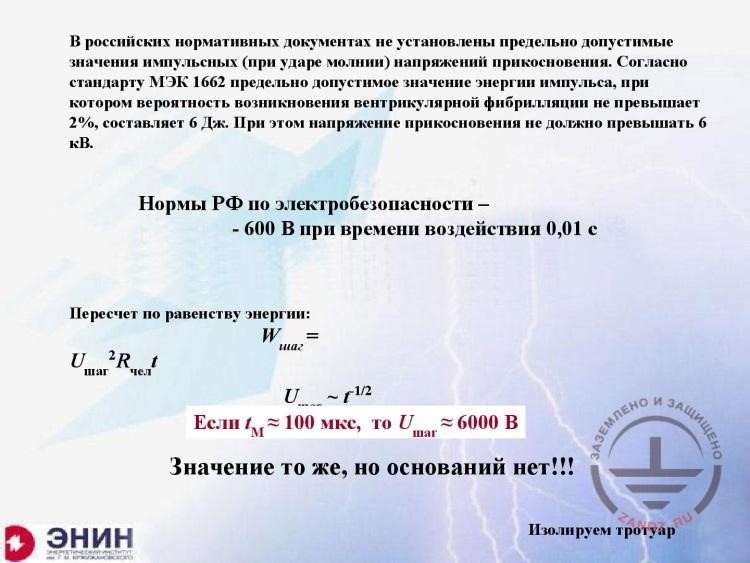
Russian standards for the electrical safety
| В российских нормативных документах не установлены предельно допустимые значения импульсных (при ударе молнии) напряжений прикосновения. Согласно стандарту МЭК 1662 предельно допустимое значение энергии импульса, при котором вероятность возникновения вентрикулярной фибрилляции не превышает 2%, составляет 6 Дж. При этом напряжение прикосновения не должно превышать 6 кВ. | In the Russian regulatory documents, no maximum allowable values for the pulse (during the lightning strike) touch voltages. According to standard IEC 1662, the maximum allowable value of the pulse energy, wherein the probability of ventricular fibrillation does not exceed 2%, is 6 J. With this, the touch voltage should not exceed 6 kV. |
| Нормы РФ по электробезопасности – 600 В при времени воздействия 0,01 с | The RF electrical safety standards — 600 V with the exposure time of 0.01 s |
| Пересчет по равенству энергии: | Re-calculation in terms of the energy equality: |
| Wшаг = | Wstep = |
| Uшаг2Rчелt | Ustep2Rperst |
| Если tM ≈ 100 мкс, то Uшаг ≈ 6000 В | If tL ≈ 100 mcs, then Ustep ≈ 6,000 V |
| Значение то же, но оснований нет!!! | The same value but no reasons!!! |
| Изолируем тротуар | Insulate the pavement |
– What can we do? Where can we find some standards? I have not found any of them except for IEC 1662. It contains the following information: the risk of heart fibrillation is 2%, if the electrical energy going through the human body provides an exposure of 6 kJ. It is all the same to be because these 6 kJ may act for 24 hours or may act for 10 mcs. The question is: will the exposures of these kilojoules be the same? Certainly, not. They are probably different but it says nothing else about it. But it also states that the touch voltage should be not more than 6 kV. In general, this value can be used because if you re-estimate the energy in terms of our 600 V at 0.01 second, then 10 mcs is a typical exposure of the lightning current, and you will obtain the allowable value of 6 kV. But this value has not been rated, and we cannot use it.
| Молниезащитная сетка – это не ошибка нормирования, а ошибка нашего восприятия | The lightning protection grid is not a rating but our perception mistake |
| 2.11. Защита от прямых ударов молнии зданий и сооружений II категории с неметаллической кровлей должна быть выполнена отдельно стоящими или установленными на защищаемом объекте стержневыми или тросовыми молниеотводами… При уклоне кровли не более 1:8 может быть использована также молниеприемная сетка… | 2.11. Protection against the direct lightning strike into the buildings and structures of Category II with the non-metallic roof should be provided with the standalone lightning rods or wires or the ones installed on the protected facility. … With the roof inclination of not more than 1 : 8, a lightning protection grid may also be used. |
| 2-5 м | 2 to 5 m |
| Установка молниеприемников или наложение молниеприемной сетки не требуется для зданий и сооружений с металлическими фермами при условии, что в их кровлях используются несгораемые или трудносгораемые утеплители и гидроизоляция. | Installation of the lightning arresters or the lightning protection grid is not required for the buildings and structures with metal frames, provided that their roofs are made of inflammable or hardly flammable thermal insulators and water proofing. |
– That is why we need a new regulatory document. But the touch and step voltage is not only about the people's safety, it is even more about the safety of the electronic equipment, because the electromagnetic interferences occur due to the significant redistribution of the voltage in the earth. However, we need to hold a special seminar to give consideration to this issue. I will return once more to the lightning protection grid. I would like to have some more of your time to say that you and I read regulatory document RD 34 not the way we should have done it. I will read item 2.11: "Protection against the direct strikes of the lightnings into the buildings and structures of Category II with non-metallic roofs should be performed using the standalone lightning rods or the lightning rods installed thereon. And with an inclination of 1 : 8, the lightning protection grid may be used". With an inclination of not more 1 : 8. What is the matter? Here is what the grid is intended for. If we do not use it the way we are going to do it. Look at the left figure: the horizontal grid is placed upon the non-metallic roof to protect people and equipment on the top floors, which are distanced from the ceiling of such roof for 2.5 to 3 meters. And, indeed, if the lightning strikes here, the distance will not be broken and the person will be protected. But if the roof is made with a significant inclination, then this distance will be much lower and then, the reverse crossing may occur and either a person or equipment may be damaged on the top floors. This is how the requirement was developed. The grid is installed on the non-metallic roof, but we install it God knows where. Including on the reinforced concrete plates containing the concrete reinforcement. And it does not matter if we have installed this grid on concrete reinforcement or not. It will not change anything. But the state standard and Gostekhnadzor require this grid. To avoid the problems with them, we continue using the grid, although it is completely useless in this regard, but its use is clearly stated in document RD 34, if you correctly read the text contained therein. And I will finish at this point. If you have got any questions, I am ready to answer them.
Questions and answers
– Dmitry Prosvirin asked: "The requirements for electromagnetic compatibility (EMC) and lightning protection of the poles and antennas in the territory of open distribution devices are defined in the EIC. What regulatory documents govern the standalone communication antennas and cables, air of the open distribution devices in the buildings, administrative?"
– Our seminar today is dedicated to the external lightning protection, but not to the protection against the electromagnetic interference. Let's ask questions on the webinar subject. Why do I consider these questions to be incorrect to some extent? It is because all instructions associated with the protection of these special devices, e.g., radiotechnical devices, are rated in their industrial standards. And such industrial standards are required to discuss them. You must know them particularly. And in this case, I am not ready to answer because I do not know the requirements that are specified for the protection of the antenna systems in this case. I can only say what is done in such conditions. If these antennas do not allow the direct lightning strike, then the isolated lightning protection is usually installed thereon. The lightning arrester is installed with the insulation designed for about one million volts. And then, the current coming from this lightning arrester is taken away by the special lightning arrester having a semi-conductive coating that may withstand about one million volts. It is a protection against the direct strikes. Moreover, protection from the power supply is provided: it is either 48 V, or 24 V, using the SPDs. In addition to this, the protection for the high-frequency channels is used, if the signal is taken not from the fiber optic cable but from the metal cable. However, the details of these questions are described in the official regulatory documents.
– Question from Artem: "How to deal with the step voltage? How can we eliminate it?"
– What can I answer to this question? In general, to eliminate it in the large area, no other opportunity exists except for the activities, which have been taken recently in the new stadiums prepared for the 2018 World Championship. What has been done there? A grid was installed there having a step cell of about 15 x 15 centimeters. And a dielectric coating was provided on the grid, which was made of synthetic materials. In these cases, we checked the protection reliability, which is very high, but this is expensive. What do people do in other locations, e.g. near the buildings? In general, they do almost nothing, because they only think about the asphalt, which is laid on the buildings, and that God will help. It is rather expensive to perform such high-reliability protection against the step voltage, but you cannot avoid it. Probably, it is a reason why these standards are not introduced. This is my personal opinion.
– Andrey asks: "Can we make an earthing from black metals or not? I mean, in the earth. Different experts say differently".
– Let's follow the regulatory documents rather than the experts' opinions. According to the regulatory documents, it is prohibited to make the earthing electrodes of aluminum and aluminum alloys, because these materials corrode in soil very quickly. Referring to the black metals, they are not prohibited in any way, neither zinc-coated, neither copper-coated, neither coating-free. It is a different matter that, every year, you are obliged to look after this earthing by uncovering about 1/6 of the earthing device area each year to make sure that the earthing electrodes as well as their connections are intact. If you make them from copper, you will be able to live without any problem for several dozens years. If you make them from black metal and install in the bog, as, e.g., in my house. The pipes having a diameter of about 300 mm were replaced every 2 years there. They decayed completely. This is what the situation is.
– Thank you. The next question from Semen and other participants: "What does the lightning protection of the Ostankino Tower look like?"
– The lightning protection of the Ostankino Tower is a complete null. I will explain, why. Let's consider the following point. First, what do we protect there? The metal structures of the Ostankino Tower are composed of the stressed reinforced concrete. Such stressed reinforce concrete is pulled using 72 metallic wires with the thickness equal to the half of my hand, even a little more. The lightning current flowing along these wires may not lead to any deformation of these wires, overheating or anything else. Let's proceed. Then, what is the specifics of the Ostankino Tower damage? The Ostankino Tower receives about 30 lightning strikes per year, among which 27 to 28 strikes are those that go from the tower to the cloud; these are the ascending lightnings. And such strikes go not only from the top of the tower, from its flagstaff. About two or maximum three strikes get into the side surface of the Ostankino Tower. So what? Nothing happens to this surface. But there can be a void in the reinforced concrete after the strike, although the Ostankino Tower can easily withstand it. Therefore, there is no special lightning protection for the Ostankino Tower.
– Igor asked: "Do I understand it correctly that there is no point in separate circuits for the functional earthing?"
– I would not say that for sure because I have said what percent of the current gets there. But predominantly the way it is implemented in practice makes no sense. When will it be useful? It will be only when this earthing circuit will be installed far enough. But in the construction or production area, there is usually no other place to install it from the side, because the area is completely built. It means that we can only do one point, to install it deeper. To install the circuit in the depth, we have to place 20 to 30 meters of the isolated cable and only after that, we can expose the electrode that will come in contact with the soil. Such isolation of the cable should be designed for the following value: the earthing resistance of your earthing devices should be multiplied by the estimated lightning current. If you have got, e.g., an earthing resistance of 10 Ohm and current of 100 kA, then it turns out that the isolation of this cable should be designed for one million volts for breakthroughs. It is made of polychlorvinyl, and a diameter of such isolation will be 200 mm. It is expensive.
– The next question from Vladimir: "One of the expert boards requires that, during the estimation, we would consider not the relative surface height, but the height relative to the earth. What do you think about it?"
– If we are talking about the Russian document, I would not ask such question because it is rather complicated. The point is that, if we require the literal implementation of all the items specified in the Russian documents, then yes, we have to consider the absolute height. But this is incorrect and depends on the roof design, the roof dimensions and the locations where the lightning arresters are installed. The European regulatory documents contain other mistakes. They provide calculations based on the roof irrespective of the lightning arrester location. Our studies have demonstrated that depending on the roof dimensions and depending on how far the roof edge is shifted from the lightning arrester, either this or that situation is correct. Neither regulatory document specifies this. Therefore, the regulatory authorities that require this from you, they are formally correct. Although in practice, they are not.
– Thank you. The next question is from Vladimir: "How much the radius of collection of lightnings of the lightning protection system is reduced with a spherical or semi-spherical tip?"
– What is a spherical or semi-spherical tip? What are their diameters? If the radius of this tip is spherical or semi-spherical at about 1 to 3 centimeters, then you can ignore this at all; neither regulatory document specifies this. And even the software I told about several times does not contain this information. I know that the work is being performed and they try to do something like this. But when and what will it result in? I think nothing will work out. If these are the radii at the order of centimeters, it does not matter.
– The next question from Sergey: "When should the calculations for the lightning protection be performed according to RD 34 and when should they be performed according to SO-153?"
– I can only say the things that were in the 2004 meeting with Gostekhnadzor. We have to efficiently manoeuver between these two documents. And it is probably correct because how can you perform the calculations for the lightning protection only according to SO-153, if this document does not contain any instructions regarding the earthing resistance value. There are no instructions regarding calculations and installation of the current collectors. We cannot use only SO-153 in this case, but if you choose the lightning arrester, then it is probably better to use SO-153 because it contains the particular and justified protection reliability values. It contains the lightning arresters having a reliability of 0.9, 0.99, and 0.999. Therefore, we have to combine the documents. There is no other way out until we have got this unlucky document. I do not know if I will be able to stay alive until then.
– Thank you. The next question seems to be popular. I have already read it somewhere, probably in forums. Alexander asked: "Is the installation of lightning arresters inside the building allowable?"
– We have got the following instructions regarding this. Document SO-153 states that the current collectors may be installed under the decorative wall coating, provided that these coating are non-flammable. No more documents except for RD 34 provide instructions. RD 34 states that the current collectors must be laid, if it is possible, in the locations that people cannot touch. It is an important note, because if you install a current collector inside the building, people can touch it; there is nothing good in that. But today, the special isolated devices with a special isolation are used for current collectors. I think there is nothing bad in it if these current collectors are installed inside the building. But I repeat that there are no instructions with regards to whether we can do it or not in any regulatory document. It will be up to you.
– The next question from Alexey. It is rather long and I will try to read it correctly. The question from regulatory document RD 34 with regards to the grid installation, the quotation can be probably used here: "non-flammable or hardly flammable thermal insulation": "There are no such terms in the effective classification of construction materials. Is it correct that the entire grid for the roofs made of melting materials (they refer to flammability Class D) should be installed atop of them?"
– I will tell you once more. Installation of the grid as it is in Russia, when it is installed on top of the reinforced concrete plates, is a complete absurd. And you have to meet these requirements only to receive your certificate of acceptance of the lightning protection signed by the Gostekhnadzor's official. Install it inside or outside, it will not be efficient. You can install it externally, and it will not work. You can install it internally, and it will not work. But in this case, it is better to install it outside because it is very difficult to prove that your insulation or water-proof coating are not flammable. But I repeat that the use of the grid on the reinforced concrete plates is crazy. It is not needed for anyone except government officials.
– The next question is similar to that related to the installation of the current collectors inside of the building. Nikolay asked: "Can a current collector (i.e. a PV wire) from the metal roof be made inside the transformer substation?"
– What for? I have got a question: why? What is the purpose? Why do you need to install it inside the building? I can understand this in the larger buildings with the larger area. But why do you need it in the transformer substation? I mean that it is probably a closed transformer substation? Install the current collectors outside of the building.
– Let's go to the next question from Artem: "How to reduce the danger of step voltage near the building?"
– I have already answered this question. I have got nothing to add to it.
– Good. Let's go to the next question. Dmitry asked: "What is the brief general strategy for using the existing regulatory documents and the calculation methods for the maximum accurate determination of the protection zones for the lightning systems?"
– I cannot answer this question because I have got no relation to the administration. I do not know what ideas they have got and what they consider to be more accurate. But I can say that the calculation of reliability of the protective action of the lightning arrester systems is not suitable for some industries. And now, the industries begin to look for the opportunity to create the calculation methods for the number of lightning strikes with a greater confidence. What does it mean? E.g., people are interested not in the lightning strike, but in the lightning strike with the current exceeding a level that is dangerous in this industry. And such work is being currently performed in Russia. It may result in that the calculation method for the lightning arresters we use today will change dramatically. It means that not the lightning strikes and probabilities of the lightning breakthrough will be calculated but the probabilities of the breakthroughs of the lightning with a dangerous power. This is the difference. Such work is being conducted.
– Thank you. Nikolay has clarified his question with regards to the installation of the current collectors inside the building. He wrote: "Yes, KTP 10/0.4 kV. This is a manufacturer's solution and we, as the designers, cannot influence in any way on the plant and this solution".
– So, do you mean a cabinet? This transformer substation, as far as I understand, is a metal cabinet. Why do not you use the cabinet itself to drain the lightning current, since it is made of metal. I cannot say anything on behalf of the manufacturer.
– Nikolay added that it was a concrete enclosure.
– I would install it outside.
– Nikolay, has Eduard Meerovich answered your question? If not, then please detail.
– Just write an e-mail to the webinar administrators, and we will contact you. I will try to understand your need.
– Nikolay wrote that the question has been already answered. Regarding the additional questions, if they arise, send them to our e-mail and we will contact Eduard Meerovich. Irina asked: "Our expert objects against the use of concrete reinforcement in the reinforced concrete structures of a skeleton-type building as current collectors, and insists on using separate current collectors installed along the external wall. Is he right?"
– He is not right. First, because the reinforced concrete structures having the coupling from top to bottom can be used for draining the lightning current, but the major point is that if you do not want to load these structures, and I do not know the reason for that, then you have to make the isolated lightning protection system. Install the isolated lightning arresters and make the isolated current collectors along their entire length. If you do not do this, then the current will flow along the reinforced concrete structures anyway. And some current will get into your current collectors, but it will not be much.
– The next question from Yury is very interesting: "Is it true that the uranium tip of the lightning arrester increases the lightning engagement?"– This question was closed about 30 years ago. The last radioactive lightning arrester in Moscow was de-
installed, I think, approximately in the 1980s, because it was found on the building erected for the exhibition center for Belgium. It is well known in the world that the efficiency of such lightning protection is equal to zero. The lightning arrester with or without a radioactive tip operate exactly the same. Even in the laboratories, when we tested them, although I did not want to, we did not determine any difference of even about 2%. This question was resolved very long ago. Frankly, in the Institute of Marie Curie in France, the capsule with radium that emits more radiation than uranium was hung in a gap of 1 meter, and they looked at how the electrical strength of such gap changed. It did not change at all. This is a very old question. Close it and forget about it.
– Thank you. Let's proceed. Ilya asked the question and Valery had a similar one. I know that you, Eduard Meerovich, answered it many times, but I ask you to repeat it again, although it may be only yes or no. "I ask you to clarify once again, why it is not feasible to use the lightning grid on flat reinforced concrete roofs". And the question from Valery: "It appears that the lightning grid on top of the reinforced concrete roof is not needed. Is it true?"
– It is correct, the grid is not needed there. Please understand that any lightning arrester operates only if it is located higher than the structure to be protected for a significant distance. In Russia, protection zones of the lightning arresters do not protrude from the top, but for this reason, they come out lower than the top generally at the distance of at least one meter. If you have got a reinforced concrete plate, it has got a concrete reinforcement. The reinforcement is earthed. You install a grid over it and, thus, the grid is now located above the reinforcement for about 1 or 2 centimeters. Please specify how the lightning, when it passed the path of 3 kilometers, can identify these 2 centimeters of height difference. The number of strikes into reinforcement rods of a reinforced concrete plate and into the grid will be almost equal. The grid does not provide any protection. The grid was designed to provide a single purpose: to protect the equipment on top floors of the building. When the roof is dielectric, the grid is required because it will exceed the metal items installed on the top floors by at least two meters. If you want the grid to operate, elevate it over the roof for 2 to 3 meters. It will start operating and provide protection. But when it is installed on the plate with the elevation of 0.5 mm, it cannot protect.
– Thank you, Eduard Meerovich. Let's proceed to the next question: "When protecting electrical equipment on the roof, should we consider that service personnel may be present on the roof and assume that the protection height is equal to the height of a person?"
– What can I say? If suiciders work on your roof, although we do not have any of them in Russia, but there are in the American prisons, then you do not need to protect them. But if people are present there, you need to protect them. If this is a roof of a high-rise building, you need to provide a prompt alert system and prevent people from going there in storm. This is also a problem. For example, the work is performed on external structures of the Ostankino Tower. A prompt storm alert system is used there that provides a signal that all works on the external structures are prohibited during this time.
– Let's proceed to the next question. Yury asked a question regarding the use of non-corrosive steel: "What about the requirements for using such steel?" I take it that this question refers to some particular answer or slide.
– I repeat that, in the regulatory documents, the prohibition to use some materials in the earth relates only to the aluminum alloys. There is nothing else stated on that point. Therefore, there are many private researches available concerning the interactions between these materials, when, for example, black metals are used in reinforcement, stainless steel is used in the earthing electrodes, etc. But these questions are beyond the scope of the regulatory documents for the lightning protection. We can endlessly research the behavior of different combinations of the earthing electrodes in soils having different corrosive powers. Probably, this question is not for me. I am not an expert in electrochemical corrosion and electrochemical protection.
– The next question is from Alexey. He asked: "Standard DIN 18015 involves the use of earthing devices: a grid of 10 x 10 m under the foundation plate (not in the plate, but in the preparation layer under the plate). Is this solution used in the Russian practice?"
– You know, it is. We have even provided such solutions. For example, we installed the reactive electrodes under the foundation plate. I saw such solutions with my own eyes. And I also saw that the grid was installed under the foundation plate. Why am I saying about the reactive electrodes? Their service life is 3 and not more than 4 years. In 4 years, you have to change the cartridge for such a reactive electrode. The question is how can we do that under the foundation plate? However, I saw this design.
– The next question from Igor: "What regulatory document requires to expose 1/6 of an earthing device each year?" This is related to your answer for one of the questions.
– As far as I remember, it is SO-153. Read it. I may be mistaken, but I believe that I am not.
– Igor, if you are still here, please read this document. The next question from Andrey: "When performing calculations according to SO-153, we obtain that the radius of horizontal section rx with the height hx for a single lightning rod is less than the radius of the maximum half-width of zone rx for the dual lightning rod at the same height hx. Is there a mistake in the formulas?"
– Formulas (3.2) and (3.4) that define these two parameters are identical. You can see this in Fig. 3.3.
– A question from Igor and others. This is a popular question, we already answered it many times: "According to the regulatory documents, can we use active lightning arresters in Russia?"
– We had a special seminar dedicated to this issue. Today, we have got much evidence that the active lightning arresters fail to operate and they also have got a smaller protection radius than the lightning arresters of a typical design. Moreover, we had a seminar wherein we have showed this in details. It means that our regulatory documents do not contain any information on active lightning arresters. The sellers of the lightning arresters abuse this fact. Active lightning rods are not mentioned in any regulatory documents of any country except for France and Spain. In Germany and the USA, no advertising of the active lightning arresters is allowed. But nothing like this exists in Russia; therefore, the active lightning rods are advertised here. But I dutifully say that I do not know any single fact that shows that these lightning arresters are more efficient than the conventional ones. But there are many facts demonstrating that they operate worse than the conventional lightning arresters. It seems strange, but they are worse.
– Thank you, Eduard Meerovich. Yes, indeed, we have already had the webinar dedicated to the active lightning protection. You may follow this link to find answers to your questions. Eduard Meerovich, we have got three more questions. The question from Igor: "Can we use the reinforced concrete studs of warehouses as the earthing devices, if their lengths in the earth are 4 to 5 meters? The number of studs is around 58; Table 2... RD 34...".
– Surely, you can. Read document RD 34 regarding this. The typical dimensions of the studs are provided therein.
– Igor clarified that the structure is less than 5 meters.
– If you have got 25 concrete studs, then the number of these studs will be equal to the area of the foundation that is allowed to use as a current collector. Read RD 34 regarding this. It contains the information based on the developments and experimental research that were performed in the 1980s in our Russian Research Institute for Reinforced Concrete. This is a very good result.
– Question from Valery: "Does the single-storey private house require the lightning protection?" I think that you mean the regulatory documents.
– The regulatory documents do not state anything about the house height. The owner takes a decision on the need of lightning protection in a single-storey house. Regarding the need of lightning protection, we have got a single document stating that; it is Table 1 in RD 34. The other points are decided by the owner. If he or she wants to make lightning protection, he or she will do it.
– Thank you. Question from Nikita: "We have got a 24-floor residential house, the vent shaft protruding over the roof, and other equipment. Do we need to connect them to the lightning grid, or should we install a separate lightning arrester?"
– I have already said all I could regarding the lightning grid. The air duct designer solves the issue of whether the strike of the lightning into an air duct is allowed. If it is not allowed, then the lightning arresters should be installed because the grid will not protect it. If it is allowed, then you should not install the lightning arresters. The air duct designer takes the decision. I cannot take such decision. Ask them this question, and they will certainly answer something like this: "Not allowed", because it is easier for them. You will have to install the lightning arrester then.
– Next question: "According to SO-153... it is not clear how to particularly determine the protection levels for "conventional facilities" (protection Levels I to IV) and the reliability of protection against the direct lightning strike for the "special facilities" (0.9 to 0.999). How can we determine, in practice, the maximum allowable probability P of the lightning strike into the facility to determine the protection reliability? RD 34... contains the calculation of the expected number N of the lightning strikes and, according to Table 1, we can determine the lightning protection category".
– SO-153 does not contain any instruction for the selection of the protection level for a particular facility. In this regard, the document is simply not completed and needs to be replaced. According to the document, the customer has the right to choose the protection level at his or her own discretion. However, it must not contradict the requirements of RD-34. Here, you need to take into account that the actual reliability of zone A is 0.96, but not 0.995 as specified in the appendix thereto, while zone B has got an actual reliability of 0.84, but not 0.95.
– Next question: "Minimum cross-sections for the elements of the external lightning protection system in documents RD 34... and SO-153... are different. In SO..., they are specified only for "conventional facilities", but they are not stated for the "special facilities". According to which document should we choose it for the "special facilities"?
– The question of different sizes of protection zones was discussed during the webinar. They are different because they have got different reliabilities: it is 0.9; 0.99; AND 0.999 in SO-153 (it does not matter what facility), and 0.96 and 0.84 in RD-34. If you need to know a more accurate reliability, you should use the calculation software.
– Next question: "When using the natural lightning arresters, can we also apply the instructions provided in SO-153 (item 3.2.1.2) to the "special facilities"?
– Formally, no, since the document is suitable only for the conventional facilities. In fact, everyone uses this section since we do not have any other source.
– Next question: "According to SO-153..., the phrase "Current collectors are installed along the facility perimeter so that the distance between them would be not less than the values provided in Table 3.3" is not clear, while RD specifies that it should be not less than 25 m".
– The text contains a mistake. You should read it as "not more than". Regarding the step between current collectors, you should follow the instructions of SO-153, which take into account the struggle against electromagnetic interference. The more current collectors we have got, the weaker the interference. In 1986, when document RD 34 was developed, the authors just did not think about it.
– Next question: "According to SO-153... and RD 34..., the discrepancy during the use of the lightning grid: - the grid cell step and the distance between current collectors are different; - according to SO-153, the possibility to use the lightning grid for the "special facilities" is not clearly stated. The grid dimensions are only specified for the protection Levels of I–IV ("conventional facilities").
– Document SO-153 contains the information on the grid in the context of rules for its use in the IEC standard. The dimensions were taken therefrom. The grid installed on the roof can only be used for the dielectric roof with a particular angle of inclination in Russia. We discussed that many times, including during the previous webinar. It is annoying to come back to this question.
– Next question: "Can we use metal columns of the building as current collectors, including in the premises with explosive zone 2 (lightning protection Category II according to RD34...)? In the explosive zones of Class 2 (C-1a, C-1d), can we use the construction metal structures (columns, platforms) as an earthing bus intended for potential equalizing, protection against the static electricity, protection against the secondary lightning effects?"
– The lightning protection Category II according to the classification of RD 34 provides for the possibility of using lightning arresters installed on the roof of the facility. The possibility to use metal structures as current collectors is thereby envisaged by default.
– Thank you, Eduard Meerovich. I think we will stop at this point. Several questions were left unanswered in the chat. Dear colleagues, we have already spent 2 hours, so the limit is exhausted. We ask you to send your questions to our e-mail. We will surely answer all of them. I ask you to register for our nearest webinars. We have got a busy program this year, so please do not miss anything. Eduard Meerovich, thank you for the report and answers to all questions. I was glad to meet you!
– I want to thank, first, webinar administrators, because we can communicate this way and it is very important; and, second, all participants. What do I want to ask from you? Read regulatory documents and try to understand the benefits they provide. Because the questions we often receiv, e.g., in the Institute, are caused by the fact that a person did not read the standards. Please avoid this, because only you may get onto your affairs. Thank you again for your attention! Good-bye!
<< Previous page
slides from 10 to 20
Related Articles:


 Lightning Protection of Large Territories: Parks, Grounds, Plant Territories. Page 1
Lightning Protection of Large Territories: Parks, Grounds, Plant Territories. Page 1
 Lightning Protection of Large Territories: Parks, Grounds, Plant Territories. Page 2
Lightning Protection of Large Territories: Parks, Grounds, Plant Territories. Page 2
 Lightning Protection of Large Territories: Parks, Grounds, Plant Territories. Page 3
Lightning Protection of Large Territories: Parks, Grounds, Plant Territories. Page 3


